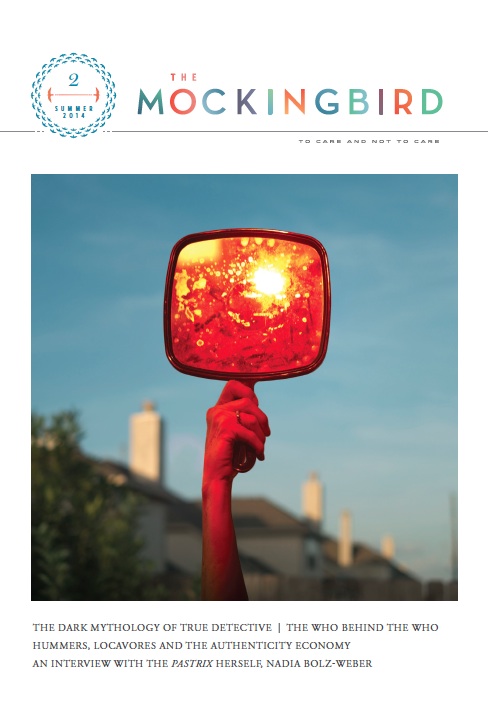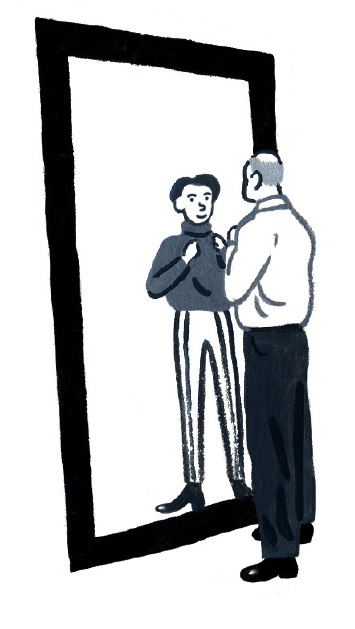
To say this second issue of The Mockingbird is more visually stunning than the first is an understatement. With lists throughout the magazine, laid out by Oxford American art director Tom Martin; with spot illustrations throughout from Masha Shabaeva-Krasnova, who does artwork for Rolling Stone, Elle and GQ; a painting from artist and children’s illustrator Oliver Jeffers’ new publication, Neither Here Nor There; not to mention poems from Mary Karr and Scott Cairns; the bar is now set in a new dimension! Suffice it to say, we are pouring everything we’ve got into this magazine, and we think you’ll be blown away with the results.
Magazines are shipping out on Friday! Subscribe now!
Below find the Table of Contents and the Opener to this summer’s issue.
 Contents
Contents
Opener by Ethan Richardson
Designated Quitter: How to Fail in Baseball (While Really Trying) by Michael Sansbury
The Confessional
Red-Circled Want Ad for My Son on His Commencement by Mary Karr
Searching Low and High for the Who Behind The Who by David Zahl
True Colors: Car Sources, Food Choices, and the Fauxthenticity of Our Times by James Haydn Gilmore
Dislocated Selves and the Truths Behind the Curtain: Identity as Given by Will McDavid
The Perils of Certainty: Six Questions for Jonathan Haidt
FOMO: Adam Phillips’ Journey through the Lives We Left Behind by Ethan Richardson
Pastor Walks in Front of Bus: An Interview with Nadia Bolz-Weber
Ready-to-Wear Me: The Target®-ification of the Emperor’s New Clothes by Aaron M.G. Zimmerman
Idiot Psalm 4 by Scott Cairns
The Heavy Unfolding by Chelsea Batten
Snozzberries for the King in Yellow: Why HBO’s True Detective Is a Religious Text by Adrienne V. Parks
Opener: A Mirror for Every Corner of Your House
After moving out of my old place this spring, I was horrified to find just how much garbage I had piled up in a small number of years. In dusty corners of the house, small reminders of who I thought I might like to be: musical instruments I never learned to play; a Rosetta Stone Portuguese program I never even uploaded; philosophy books on the shelf I thought I needed (and never once opened); a Ziggy Stardust wig and leather tights. I don’t know which is more embarrassing: the money lost on all these endeavors, or the naïveté that made each of these endeavors feel so ultimate. Craigslist helped me remove them from my life. All except the wig.
The funny thing? I am currently doing it all over again. Each piece of my new house is a new self, and ten years later, I’ll happen upon a shirt (a self?) I’d never wear again if you paid me. Maybe the same is true for you.
In developmental psychology this phenomenon is called the End-of-History Illusion. It is our tendency to believe, contrary to past evidence, that who we are now is who we will continue to be forever. Jordi Quoidbach, in his study on the illusion, describes it this way:
People have a fundamental misconception about their future selves… people may believe that who they are today is pretty much who they will be tomorrow, despite the fact that it isn’t who they were yesterday… people expect to change little in the future, despite knowing that they have changed a lot in the past, and that this tendency bedevils their decision-making.
 It seems Rod Stewart and The Faces only had it half-right. Sure, “I wish that I knew what I know now / when I was younger,” but I also “wish that I could know now what I will know then.”
It seems Rod Stewart and The Faces only had it half-right. Sure, “I wish that I knew what I know now / when I was younger,” but I also “wish that I could know now what I will know then.”
We tend not to think this way, though. We rarely think, when buying a pair of shoes, “Will I hate these shoes in a couple years?” Who can tell how we’re going to feel, anyway? And this is not just true for the stuff in our closets, but for the persons who wear them, too. We have an inbuilt sense of omniscience when it comes to our lives. We tend to believe that this self now—or the self we are envisioning—is the Final Self, the one that won’t need discarding, changing, or hiding, like all the rough drafts did before.
It comes as no surprise to us when we see someone else’s Final Self come crashing down. In Hollywood, we actually crave it. As the hate-worship saga continues upon the life of Gwyneth Paltrow, the biggest surprise about her split with Coldplay frontman Chris Martin wasn’t that it felt so curated (she called it “conscious uncoupling”), but that it felt so good to finally justify the disdain. We judge from the couch, She just isn’t who she thinks she is.
So, who are you now? What Final Self is writing the story as you read this? What elements of you will continue to be you when you awake tomorrow? Next month? In ten years? And what will be gone?
The Catholic writer Henri Nouwen talks about the experience of losing, painfully, all remnants of his Final Self. As a celebrated theologian working in an upper-echelon institution, he left the world of his accomplishments to begin working at a center for the mentally and physically disabled. Here’s how he describes the experience:
This experience was and, in many ways, is still the most important experience of my new life, because it forced me to rediscover my true identity. These broken, wounded, and completely unpretentious people forced me to let go of my relevant self—the self that can do things, show things, prove things, build things—and forced me to reclaim that unadorned self in which I am completely vulnerable, open to receive and give love regardless of any accomplishments.
 Notice how this “unadorned self” Nouwen describes is devoid of any talk of potential or possibility. All the detritus left of the project of a Final Self is wiped clean and, in its absence, the real self emerges. This seems to make sense of John the Baptist’s poignant surrender at the arrival of Christ: “He must increase, but I must decrease” (Jn 3.30). Maybe there’s something to this unadorned self. Maybe this is the point at which we really do find the “end-of-history” solution, where none of our varied stories of ourselves—past, present, or future—come to matter nearly as much as the one given us in our weakness.
Notice how this “unadorned self” Nouwen describes is devoid of any talk of potential or possibility. All the detritus left of the project of a Final Self is wiped clean and, in its absence, the real self emerges. This seems to make sense of John the Baptist’s poignant surrender at the arrival of Christ: “He must increase, but I must decrease” (Jn 3.30). Maybe there’s something to this unadorned self. Maybe this is the point at which we really do find the “end-of-history” solution, where none of our varied stories of ourselves—past, present, or future—come to matter nearly as much as the one given us in our weakness.
This issue of The Mockingbird is the Identity Issue. In it we cover the various ways in which we try to answer the question, “Who am I?” You will read about benchwarming ballplayers, sell-out hipsters, and the greatest ladder-climbing trickster of them all, Jacob, son of Isaac. You will crunch the numbers within the authenticity economy. You will look at the hashtag obsession known as FOMO (fear of missing out), especially through the work of psychoanalyst Adam Phillips. There are essays on Pete Townshend and The Who, and on the HBO sensation, True Detective.
So here’s your glimpse into the mirror, and to the hope that stands beyond it. We hope you enjoy.
Ethan Richardson
Editor
ORDER OR SUBSCRIBE TODAY!

COMMENTS
3 responses to “OUT NOW – THE MOCKINGBIRD, No 2: THE IDENTITY ISSUE!”
Leave a Reply













Looks incredible! Can’t wait to read the Nadia Bolz-Weber interview (and all of the rest of it too). As SMZ put it so eloquently: “The new print magazine from Mockingbird is first-class – if you are interested in creative, gorgeously-designed cultural, literary, and theological commentary, the bar is now set very high. Well done Dave, Ethan, et al.”
I cannot wait to get it! I’ve gotten to where I can’t wait to read Will McDavid’s stuff. It all looks fantastic. Print is the new thing now!